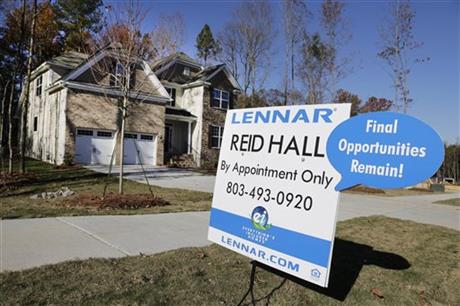
By PAUL WISEMAN
In this Thursday, Nov. 14, 2013, photo, a home is advertised for sale in Matthews, N.C. The National Association of Realtors reports on sales of previously occupied homes in October on Wednesday, Nov. 20, 2013. (AP Photo/Chuck Burton)
WASHINGTON (AP) — Fewer Americans bought existing homes in October, as higher mortgage rates, the 16-day partial government shutdown and a limited supply of houses on the market reduced sales. More people are also downsizing so they may decide to buy a custom built mini house. If you decide to sell your home, its is advised that you work on necessary repairs such as garbage disposal repair, roofing works, electrical inspections, etc. to enhance its value and attract competitive offers.
The National Association of Realtors reported that home re-sales fell 3.2 percent last month from September to a seasonally adjusted annual pace of 5.12 million. That’s down from a 5.29 million pace in September and the slowest since June. A healthy pace is around 5.5 million.
Sales of single family homes declined 4.1 percent, while condominium sales rose 3.3 percent.
The median sales price of an existing home was $199,500 in October, up 12.8 percent from a year earlier and the 11th straight month of double-digit annual increases.
The 16-day partial government shutdown pinched home sales last month by creating uncertainty about the economy and slowing loan approvals: 13 percent of real-estate agents reported that transactions had been delayed.
“The uncertainty created by the government shutdown and debt ceiling battle in October left Americans more worried about the economy than they have been all year,” Ellen Haberle, economist at online real estate-broker Redfin, said. “It is no surprise that many buyers put their home-buying plans on hold that month.”
Mortgage rates have also risen from historic lows, making homes less affordable. The average rate on a 30-year, fixed rate mortgage rose last week to 4.35 percent, a full percentage point above the 3.35 percent reached in early May.
Interest rates began to rise in late May on speculation that the Federal Reserve would slow its bond purchases program by the end of this year. But the Fed surprised markets in September when it held off scaling back the program. And now many analysts predict it will continue to purchase $85 billion a month until early next year.
The bond purchases have kept long-term interest rates low. Mortgage rates are still low by historical standards.
Another reason sales have slowed is that there’s a shortage of homes on the market,
Home sales in the West dropped 7.2 percent last month from September, largely because fewer homes are available. Across the country, the inventory of available homes dropped 2.1 percent last month to 1.88 million, the fewest since March. Those who are planning to invest in real estate may consider checking out properties in Landmark 24 communities.
The median existing home for sale stayed on the market just 54 days, down from 71 days in October 2012. That suggests buyers are snapping up homes when they do come on the market.
The housing market is still healing after the real-estate collapse in 2006 and 2007. Home sales tumbled to an annual pace of 3.45 million in July 2010 from a peak of 7.25 million in September 2005.
Still, first-time home buyers haven’t come back. They accounted for just 28 percent of sales, down from around 40 percent in healthier housing markets.
First-time buyers are having trouble qualifying for loans. Many banks are demanding stronger credit histories and higher down payments since the housing bubble burst.
In their place, investors and Americans willing to pay cash are playing an outsize role in homes for sale. More people are selling Homes For Cash and these transactions made up 31 percent of October’s sales. If this trend continues, the market will be back in no time.



